How to Create an AI GTM Strategy From the Ground Up

How to Create an AI GTM Strategy From the Ground Up
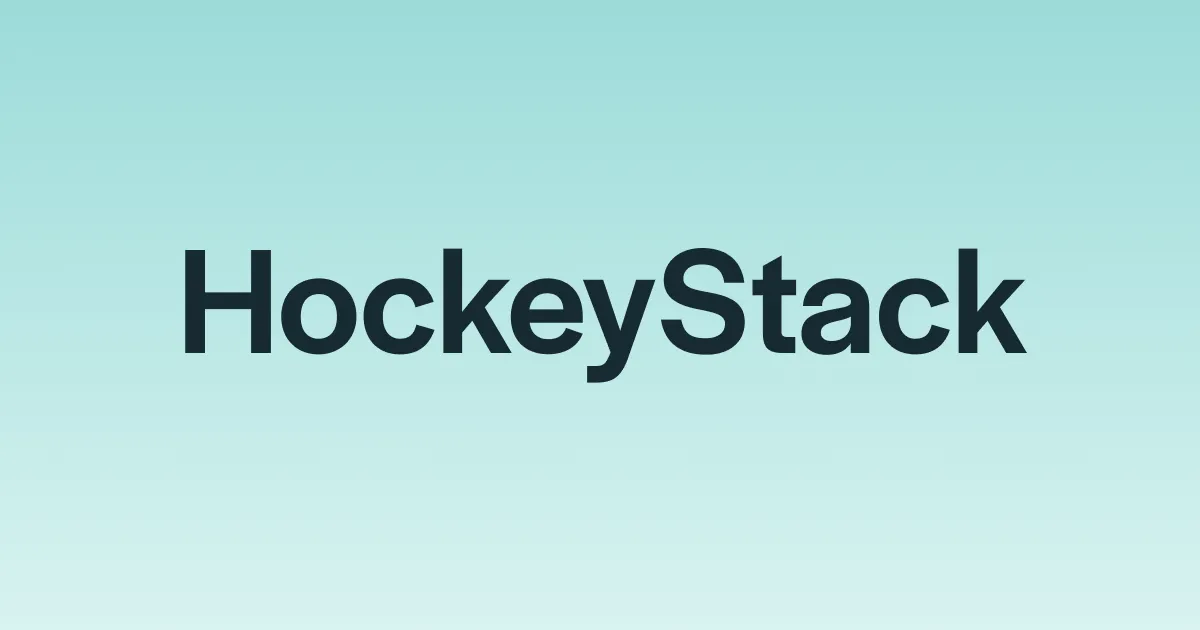
Right now, there's probably an account on your website comparing you to competitors. They downloaded your whitepaper yesterday, a few employees checked your pricing, and their CFO just spent 12 minutes on your security page.
Do your AI tools know this is happening? And more importantly, have they done anything about it?
If the answer is no, then you don't have an AI GTM strategy. You just have a few disconnected AI tools that have no clue this account even exists.
A real AI GTM strategy means your system sees these buying signals in real-time and automatically orchestrates the response. The system automatically flags the account, alerts the right rep with context, and launches the marketing sequence.

Below, we'll break down what a working AI GTM strategy looks like, which capabilities matter most, and how to build it step by step in your organization.
What is an AI-Driven Go-To-Market Strategy?
When most people say they have an "AI GTM strategy," it usually means they bought an AI email writer that's basically a ChatGPT wrapper. Maybe they even have a lead scoring tool that uses "machine learning" somewhere in there.
That's not what we're talking about here.
Think about how your revenue team works today. Marketing drives leads based on who filled out a form or opened three emails. They pass these MQLs to sales, who quickly discover half are students, competitors, or people who will never buy.
Meanwhile, your actual buyers are invisible. They're on your website right now, reading documentation, checking pricing, comparing you to alternatives.
But since they haven't filled out a form, nobody knows they exist. And by the time they finally request a demo, they've already made their decision.
A true AI-driven GTM strategy rebuilds your entire revenue engine around unified intelligence. It creates a central system that connects all your GTM data, outlines opportunities across the full buyer journey, and automatically coordinates every team's response.
Here's what changes when you move to AI-driven GTM:
- Predictive analytics on every account: You stop making decisions based on last quarter's reports. AI analyzes thousands of real-time signals like website visits, content consumption, and peer activity. Teams see buying intent building while competitors are still waiting for demo requests.
- Automated workflows replace manual processes: Sales teams waste 70% of their time on admin work today. AI takes over the busywork — it updates your CRM, triggers follow-ups based on what prospects do, and generates reports automatically so your team can focus on sales.
- Unified revenue engine across all teams: Marketing, sales, and customer success stop operating in separate bubbles. When marketing spots a high-intent account, sales know immediately with full context. When a key customer's usage drops, success and sales coordinate the save together.
The Role of AI in Transforming Go-to-Market Strategies
Building a GTM strategy used to mean months of manual research, Excel models based on old data, and making your best bet on which accounts to target.
You'd pick your segments, write your message, choose the channels, and hope you got it right.
That doesn't work anymore. Buyers do 70% of their research before they ever talk to you. They've compared options, read reviews, and formed opinions. And the company that responds fastest and with the most relevant message usually wins.
GTM AI gives you the speed and intelligence to compete. It handles the analysis and repetitive tasks, so you can focus on building better customer relationships and iterate your go-to-market plays.
Here’s exactly how AI upgrades the core functions of a traditional GTM strategy.
Market & Customer Research
The old way → You spend weeks reading analyst reports that are already six months old. Your customer segments are "enterprise companies in financial services" or equally broad categories that tell you nothing useful.
The AI-powered way → AI monitors your market continuously. It tracks what your competitors launch, what customers complain about on Reddit, and which accounts are researching solutions like yours. You get specific intel like "companies that just raised Series B and are hiring sales teams."
Positioning & Pricing Strategy
The old way → You interview ten customers, write messaging based on what they said, and copy your competitor's pricing page from last year. You hope this works.
The AI-powered way → AI analyzes every sales call, support ticket, and customer review to understand customer needs and what messages make people buy. It tests different value propositions across segments and tells you what works where. For pricing, it models how changes affect conversion and expansion revenue.
Marketing & Sales Execution
The old way → You run an A/B test and wait three weeks for statistical significance. Your SDRs call everyone who downloaded an ebook. Campaign optimization happens monthly when you remember to check the dashboard.
The AI-powered way → AI scores leads based on real-time buying behavior, not arbitrary points for opening emails. It optimizes campaigns daily based on what's working right now. When someone shows interest, the right rep gets an instant alert with context about what they care about.
Customer Success & Retention
The old way → You reactively respond to support tickets and check in with customers quarterly through generic surveys. By the time you notice a customer is unhappy, they're already shopping for alternatives and your renewal is at risk.
The AI-powered way → AI monitors customer health signals like product usage patterns, support ticket sentiment, feature adoption, and engagement drops. It predicts which customers are likely to churn weeks before they show obvious signs and automatically triggers personalized outreach campaigns.
The Real-World Benefits of an AI GTM Strategy
We've covered what AI-driven GTM looks like in theory. Now let's talk about the specific benefits it delivers for your business:
Move at the Speed of the Market, Not the Speed of a Spreadsheet
Traditional GTM teams run on monthly reports. You analyze last quarter's performance, debate what it means, then roll out changes weeks later.
AI-driven GTM reacts instantly to what's happening. When your competitor changes their pricing, you know the same day. When a campaign starts working with enterprise accounts, the AI automatically moves the budget there while it's hot. No waiting for the monthly report to tell you what you missed.
McKinsey found that companies using real-time analytics see 23x higher customer acquisition rates. It’s obvious that the speed difference isn't just nice to have anymore.
Free Your Team from Robotic Work
Look at what your team actually does all day. Reps log calls, update deal stages, and research prospects on LinkedIn. Marketing exports lists, cleans data, and builds the same reports every week. Everyone's doing work that a computer should handle.
AI handles all this administrative overhead automatically. It updates CRM fields from call recordings, builds reports overnight, and researches prospects before the first call.
Another McKinsey study found that 47% of employees expect to use AI for more than 30% of their work tasks within a year.
Cut Waste and Double Down on What Works
Right now, half your marketing budget targets accounts that will never buy. Your SDRs call leads who haven't even heard of you. You're running the same campaigns to segments with completely different buying patterns.
AI can show you exactly where you're wasting money and where you should invest more. It understands which channels drive pipeline, which content marketing resonates with enterprise buyers, and which accounts are worth pursuing.
Create a Truly Aligned and Predictable Revenue Engine
Most revenue teams work in silos. Marketing hands off leads to sales, sales close deals and toss them to customer experience, and each team blames the others when numbers don't hit.
Companies with strong sales and marketing alignment see 208% more revenue because they've stopped this dysfunctional handoff game and started working as one team.
AI creates this alignment because it gives all your teams a shared view of every prospect's journey and automatically coordinates actions across departments.
How to Implement AI in GTM Strategy
Most companies know AI can upgrade their GTM strategy, but don't know where to start. They either pick the wrong tools, implement them incorrectly, or expect magic results without doing the foundational work.
Here's a detailed breakdown of how to build an AI GTM strategy that works, step by step:
Upgrade Your Market Research from Static Reports to a Live Intelligence Feed
Current problem: You're making decisions based on quarterly industry reports and annual surveys that are already months out of date by the time you read them. By the time you spot a trend, it’s already too late.
How AI solves it: AI constantly scans thousands of data sources (e.g., news, social media, job postings, funding announcements) to spot new market trends and competitive moves the moment they happen. You know what's happening in your market today, not six months from now.
How to implement:
- Set up monitoring for your top 3 competitors' websites, job postings, and press releases
- Track branded and competitor mentions across social media and review sites
- Create alerts for industry keywords and new technologies in your space
- Build a weekly automated report that summarizes key market changes
⚠️Common mistakes to avoid:
- Start narrow with 10-15 key signals that drive your data-driven decisions, not every piece of market and customer data you can find
- Set up filters to outline only high-priority alerts, or you'll drown in notifications that don't matter
- Always double-check important AI insights with your own research before you make any big strategy changes
Replace Broad Personas with Dynamic Micro-Segments
Current problem: You're still using static buyer personas based on basic demographics like "enterprise IT manager" or "small business owner." These broad categories miss the nuanced behaviors and specific pain points that drive purchasing decisions.
How AI solves it: Artificial intelligence analyzes real customer behavior patterns to create precise micro-segments that update automatically as customer actions change. You get granular groups like "fast-growing SaaS companies evaluating security tools after a data breach" with specific messaging for each.
How to implement:
- Connect the AI to all relevant customer touchpoints — website, CRM, support tickets, and product usage data
- Define the behaviors and attributes that matter most for your business (e.g., pricing page visits, feature comparison searches)
- Build different playbooks for each high-value behavioral segment
- Set up automated campaigns that adapt messaging based on which micro-segment each prospect falls into
⚠️Common mistakes to avoid:
- Start with 5-8 actionable segments you can create content for, not dozens of groups that overwhelm your team
- Check your segments regularly to make sure they still match how customers behave
- Avoid making segments so specific that you end up with only a few prospects in each group
Change Your Messaging from One-Size-Fits-All to Scalable Personalization
Current problem: Your marketing team writes the same emails and landing page copy for everyone, hoping a generic "increase efficiency and reduce costs" message resonates with different industries and use cases. Most prospects ignore it because it doesn't speak to their specific situation.
How AI solves it: AI analyzes what content resonates with each segment and automatically personalizes based on industry, use case, and stage in the buying journey. Every touchpoint becomes relevant without manual effort.
How to implement:
- Connect AI to analyze your CRM data, email performance, and website behavior to see which themes convert best for different customer types
- Build a library of personalized message templates based on those actionable insights that speak directly to the pain points of each micro-segment
- Set up dynamic content systems that automatically pull in prospect data like recent web activity and company growth stage to customize messaging in real-time
⚠️Common mistakes to avoid:
- Start with a few key personalization variables, like industry and role, before you move on to any complex behavioral triggers
- Avoid creepy personalization that shows you know too much (keep it relevant and helpful, not invasive)
- Test your personalized content regularly because what works for one segment might not work for another
Focus Your Lead Qualification on Predictive Scoring, Not MQLs
Current problem: Your sales team spends hours calling people who downloaded an ebook or signed up for a demo but aren't really ready to buy anything. Standard lead scoring gives points for basic activities like email opens and form fills, but misses the real signs that someone has budget and decision-making authority.
How AI solves it: AI analyzes patterns from your closed-won deals to outline the exact combination of behaviors, timing, and characteristics that forecast genuine buying intent. You get lead scores that correlate with conversion probability, not just the engagement level.
How to implement:
- Feed your AI technology historical data from deals that closed, including all touchpoints, timeline, and prospect characteristics that led up to purchase
- Set up tracking for buying signals like pricing page visits, competitor research, stakeholder involvement, and urgency signals in communication
- Create predictive scoring models that weight these signals based on how strongly they correlate with deal closure in your data
⚠️Common mistakes to avoid:
- Don’t over-complicate the scoring model — focus on the 5-7 signals that most strongly predict deal closure
- Avoid scoring systems that penalize prospects for taking time to research (longer evaluation periods might even lead to higher deal value)
- Don't ignore negative signals like price objections or competitor mentions that might lower conversion probability
AI in Action: 5 Common GTM Use Cases
Here are five of the most common use cases where AI is delivering a massive impact for modern GTM teams:
AI-Powered ABM Intelligence
Traditional ABM targets accounts based on size and industry. You make a list of Fortune 500 companies, run some LinkedIn ads, and hope for the best.
Some marketers on Reddit have even given up on ABM campaigns completely:
“Maybe in some industries, but ABM never worked for the companies I worked for. They spent years and hired really expensive people for the job, but it just didn’t work.”
AI-powered ABM outlines accounts that are in-market right now. It tracks job postings, website visits, content downloads, and dozens of other buying signals.
When Pied Piper posts ten new data engineering roles and their team starts reading your documentation, AI connects the dots. It alerts your sales team immediately and launches an automated enterprise campaign.
💡PRO TIP: HockeyStack's AI watches anonymous companies browse your website and scores their engagement. When it finds accounts that match your ICP and look ready to buy, Nova takes over and enriches the account, finds decision makers, and starts personalized outreach. All before they submit a single form.
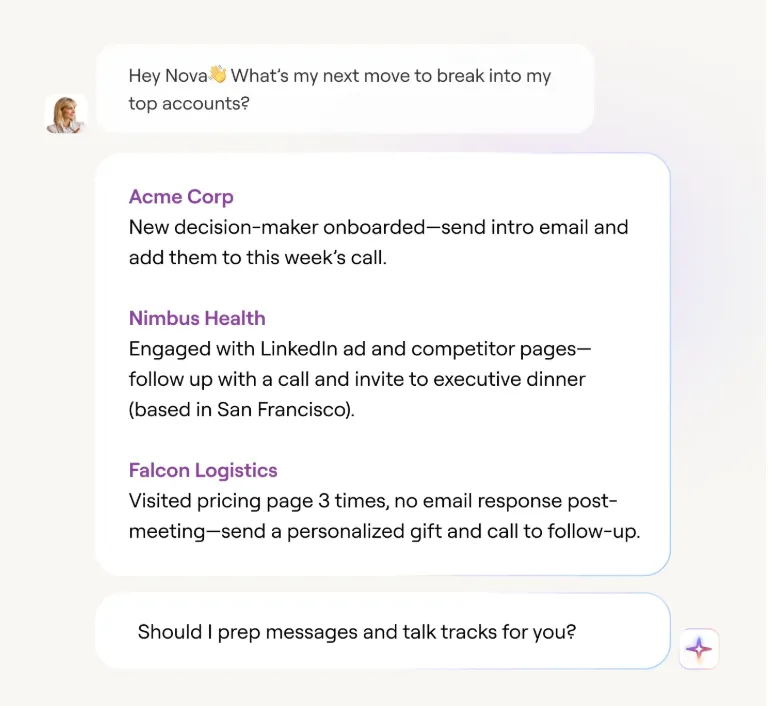
Predictive Lead Scoring and Qualification
The old MQL model is broken. Someone downloads a whitepaper and gets the same score as someone who checked your pricing three times this week.
AI scoring looks at every interaction across every channel to predict who will buy. It learns from your won and lost deals to find the patterns that matter most — like when engineers and finance both visit your security page, that deal closes 3x faster.
💡PRO TIP: Nova also looks at your historical win/loss data to build a custom scoring model for your business. It learns from every deal you close and customizes scores based on what drives conversions, not those arbitrary point values you set up three years ago.
Content and Messaging Personalization
Prospects expect messages that speak directly to their situation — their industry, their role, their specific pain points.
Generative AI makes this possible at scale. It analyzes what messaging works for different segments and automatically customizes everything from email subject lines to landing page headlines.
For example, a SaaS startup sees content about rapid scaling, while an enterprise sees compliance and security.
Learn more → AI-Driven Content Marketing Strategies for B2B GTM Teams
Full-Funnel Revenue Attribution
Most companies have no idea which marketing activities drive revenue. They credit the last touchpoint before a sale and call it a day. Meanwhile, the webinar that started the whole buyer journey gets zero recognition.
AI tracks every interaction across the entire customer journey and figures out what really influences deals.
It knows that LinkedIn ad introduced the prospect, the case study educated them, and the pricing page sealed the deal. Each touchpoint gets proper credit based on its actual impact.
💡PRO TIP: HockeyStack combines multi-touch attribution with self-reported data to show you the complete revenue story. While most tools force you to choose between first-touch, last-touch, or linear models, HockeyStack uses flexible attribution that adapts to your model — single-touch for specific journey stages and multi-touch for comprehensive funnel analysis.
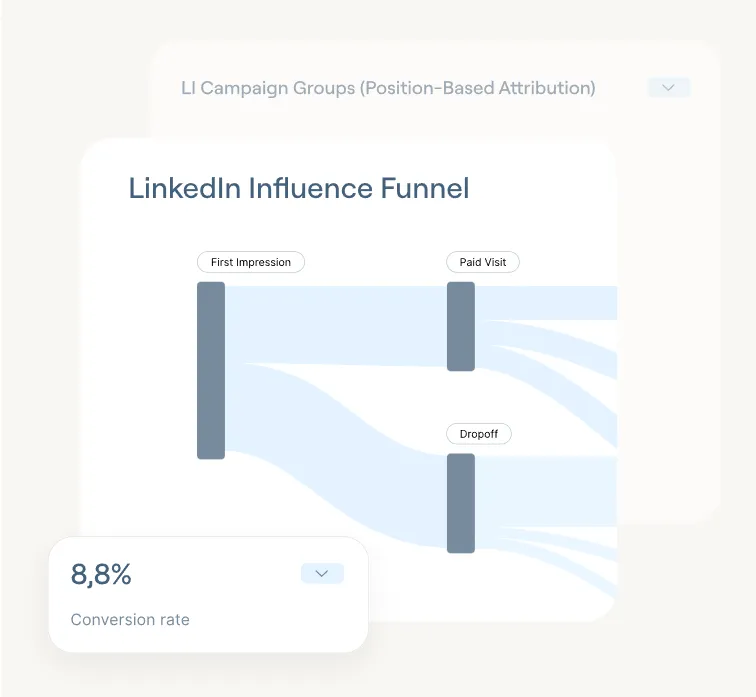
Learn more → What Is Revenue Attribution & How to Get Started with It
Customer Churn Prediction and Expansion
Your best customers leave without warning, and you find out when they don't renew. By then, it's too late to save the relationship or understand what went wrong.
You can leverage AI to spot the warning signs months before customers churn. It notices patterns like declining product usage, support ticket spikes, or key stakeholder changes.
The same system finds expansion opportunities, too. When a customer hits usage limits or their team grows, AI flags them for upsell. Your reps know exactly when to pitch upgrades because the data shows customers are ready to buy more.
💡PRO TIP: Set up automated workflows in HockeyStack to monitor product usage and engagement signals. When Nova detects churn risk patterns, it can automatically alert your CS team, create a save plan based on similar successful interventions, and trigger a re-engagement campaign.
Where AI GTM Strategies Go Wrong (and How to Avoid It)
Even with the best intentions, it’s easy to get AI wrong in a GTM strategy. Some teams overspend on fancy tools that never work together, while others use AI to speed up processes that were broken to begin with.
Before you get into it, here are the most common pitfalls to watch for and how to steer clear of them:
1. Mistaking a Single AI Feature for a Strategy
Too many companies buy one AI tool, like a chatbot or lead scoring feature, and think they've built an AI GTM strategy. They get disappointed when that single point solution doesn't transform their entire revenue process.
How to avoid it: Think platform, not point solution. A true AI GTM process is built on a unified intelligence engine that connects to all your GTM data. The goal should be to create a central command center that streamlines how your teams and tools work together, not to just add another silo.
2. Automating Your Existing Broken Processes
If your lead handoff process is already a mess, automating it just creates faster chaos. You end up with AI that efficiently executes the wrong strategy or scales up processes that shouldn't exist in the first place.
How to avoid it: Get your house in order before you bring in AI. Clean up your messy data, make sure your teams agree on counts as a qualified lead, and fix your broken handoff processes. When your basics work, AI becomes rocket fuel for what's already successful.
3. Treating AI as an Inscrutable Black Box
When AI tells your team to redirect resources or prioritize certain accounts, they need to know why. If the only explanation is "the algorithm says so," your team won't trust it and won't act on its recommendations.
How to avoid it: Demand transparency. Good GTM AI platforms can break down their recommendations and explain what data led to each conclusion. When your team understands the logic, they'll trust the insights.
4. Forgetting the Human Element
AI can handle the repetitive work, but it can’t replace the judgment, creativity, and relationship-building that make GTM teams successful. When companies try to take humans out of the loop entirely, the result is cold, generic interactions that turn customers off.
How to avoid it: Use AI as a force multiplier, not a substitute. Let it handle the research, analysis, and routine tasks so your team can focus on high-value work.
Stop Buying AI Features. Start Building a GTM AI Engine.
So many companies approach AI GTM strategies the wrong way. They collect individual AI tools like trading cards — a chatbot here, some lead scoring there, maybe an automated email feature.
But these tools operate in their own silos and only create more complexity.
HockeyStack is built on a different philosophy. We created a complete GTM AI platform that acts as the central intelligence for your entire go-to-market motion.
One system that connects all your data, outlines opportunities across the full buyer journey, and coordinates every team's response.
Here’s exactly what makes it different:
It's a Unified Platform, Not a Point Solution
The average company runs its GTM on a patchwork of disconnected tools. Marketing teams have their attribution dashboards, sales operate from the CRM, and customer success manages retention in yet another system.
HockeyStack connects to your entire GTM stack through simple integrations that don't require engineering resources or months of setup.
All your scattered data, from website behavior and ad performance to sales conversations and customer support tickets, flows into one unified platform.
Everyone works from the same intelligence, makes decisions from the same data, and moves toward the same goals.
It Provides a Team of Specialized AI Agents
You don't get one generic AI that tries to do everything. You get specialized AI agents that excel at different parts of your GTM motion.
Odin AI Analyst is your on-demand revenue intelligence expert. You can ask Odin questions like which campaigns drive enterprise deals, what content to create next quarter, or why conversion rates dropped last month, and get instant answers with visual breakdowns.
It analyzes your data to recommend specific initiatives, writes comprehensive reports in plain language, and spots opportunities you might have missed. No more waiting days for custom analysis or piecing together insights from multiple dashboards.
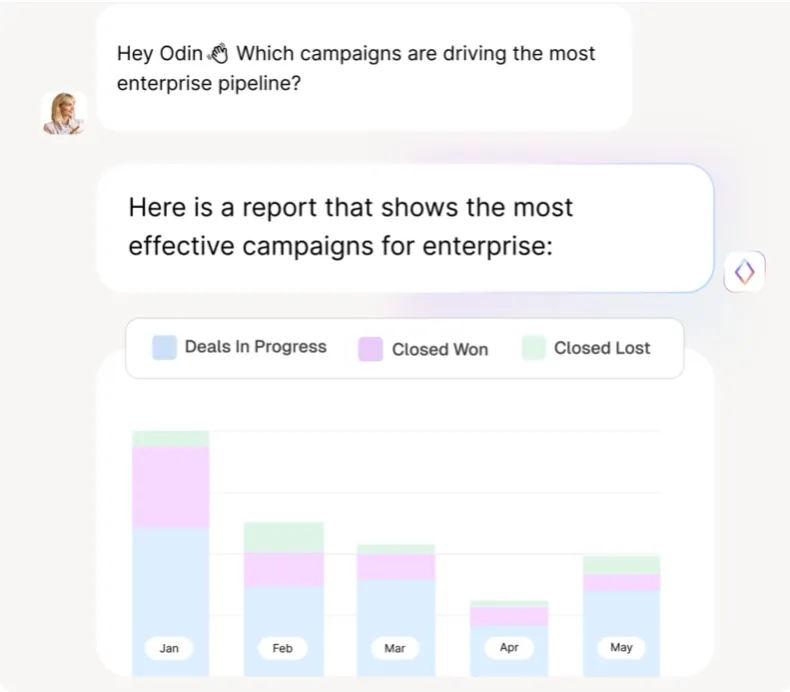
Nova works as your sales team's AI assistant on the front lines. It studies your best-performing reps and successful deals to recommend the next best action for every account.
It outlines accounts with buying signals, explains why they're ready to engage, and tells reps exactly what message will resonate based on similar wins. It handles research, scoring, and follow-up coordination so reps focus on selling.
Together, these agents create a self-improving GTM engine that understands your winning patterns and helps you scale them across every team and campaign.
It Turns Your Strategy into Automated Action
Most platforms show you insights, then leave you to figure out what to do with them. You see an account is hot, but then you have to manually update Salesforce, message your sales team, execute the marketing campaign, and hope everyone got the memo.
HockeyStack automates the entire response with GTM workflows. When our AI detects buying signals, it launches workflows automatically across your entire GTM stack.
To be specific, Odin outlines the high-intent accounts and then Nova instantly springs into motion:
- Enriches the account with company details and tech stack information
- Maps out key decision-makers and their contact information
- Updates your CRM with priority scores and buying signals
- Alerts account owners in Slack with relevant talking points
- Launches targeted email sequences with personalized messaging
- Syncs target audiences to ad platforms for coordinated campaign targeting
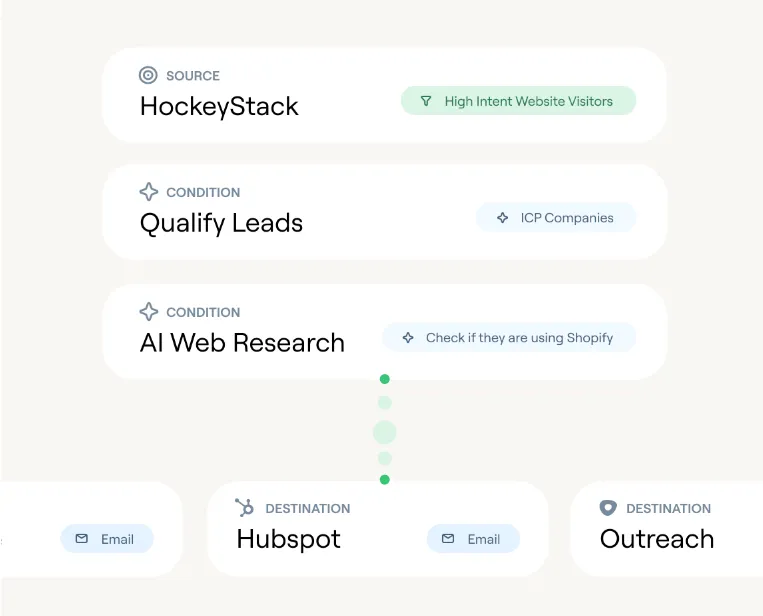
And this all happens in minutes, not the days it typically takes to coordinate between teams manually.
Your GTM team deserves better than duct-taping AI features together and hoping for the best. See how HockeyStack's AI agents work in our interactive demo.
FAQs
What is the single most important first step to start?
Clean up your data first. If your CRM is full of duplicate contacts, your website tracking is broken, and your teams define qualified leads differently, AI will just multiply the mess.
Start by connecting your key systems and creating a clean, consistent data flow. Once you build this foundation, AI can bring some major improvements.
Do I need to hire data scientists to run this strategy?
Not at all. Modern AI platforms are built for business users, not PhD statisticians. You need people who understand your market and customers, not complex algorithms.
The best AI GTM strategies are run by marketers and sales leaders who know how to ask the right questions and act on insights.
How do you actually measure the ROI of an AI strategy?
Track the same metrics you always have — pipeline generation, conversion rates, deal velocity, and customer lifetime value. The difference is that AI should improve all of these simultaneously.
Look for compound improvements like faster lead generation, higher win rates, shorter sales cycles, and better customer retention. Many companies see meaningful results and ROI changes within 60-90 days.
Can't I just buy a platform and have an instant AI strategy?
Buying a platform without a strategy is like buying a Ferrari and using it to deliver pizza. You need to align your teams, clean your data, and define clear goals before any AI tool will work effectively. The platform enables your strategy, but it doesn't create one for you.
Data-Driven vs Data-Informed: Which Approach Works for SaaS Marketing Teams?
Explore the difference between data-driven and data-informed approaches in SaaS marketing. Understand which strategy empowers your team to achieve better results.


Ready to see HockeyStack in action?
HockeyStack turns all of your online and offline GTM data into visual buyer journeys and dashboards, AI-powered recommendations, and the industry’s best-performing account and lead scoring.
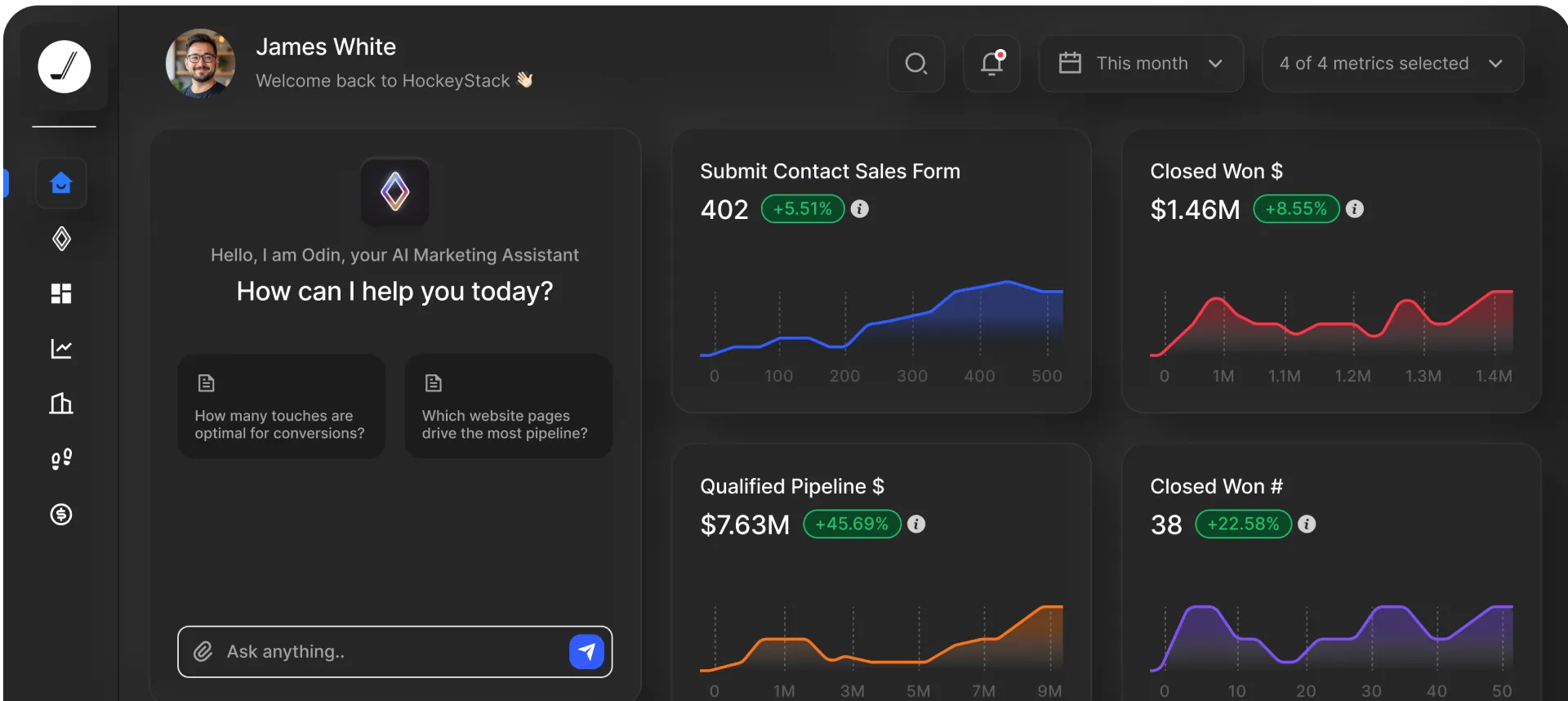
Ready to See HockeyStack in Action?
HockeyStack turns all of your online and offline GTM data into visual buyer journeys and dashboards, AI-powered recommendations, and the industry’s best-performing account and lead scoring.



